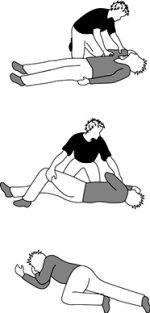David Baxter PhD
Late Founder
First aid for seizures
Epilepsy.org.uk
07 Jul 2011
Find out about our Take epilepsy action campaign, raising awareness among the general public of different kinds of seizures and appropriate first aid.
The person goes stiff, loses consciousness and then falls to the ground. This is followed by jerking movements. A blue tinge around the mouth is likely. This is due to irregular breathing. Loss of bladder and/or bowel control may happen. After a minute or two the jerking movements should stop and consciousness may slowly return.
Do...

Don't...
Call for an ambulance if...
Sometimes the person is not aware of their surroundings or what they are doing. They may pluck at their clothes, smack their lips, swallow repeatedly, and wander around.
Do...
Epilepsy.org.uk
07 Jul 2011
Find out about our Take epilepsy action campaign, raising awareness among the general public of different kinds of seizures and appropriate first aid.
- Tonic-Clonic seizures
- Seizures involving altered consciousness or behaviour
- First aid in other languages
The person goes stiff, loses consciousness and then falls to the ground. This is followed by jerking movements. A blue tinge around the mouth is likely. This is due to irregular breathing. Loss of bladder and/or bowel control may happen. After a minute or two the jerking movements should stop and consciousness may slowly return.
Do...
- Protect the person from injury - (remove harmful objects from nearby)
- Cushion their head
- Look for an epilepsy identity card or identity jewellery
- Aid breathing by gently placing them in the recovery position once the seizure has finished (see pictures)
- Stay with the person until recovery is complete
- Be calmly reassuring

Don't...
- Restrain the person?s movements
- Put anything in the person?s mouth
- Try to move them unless they are in danger
- Give them anything to eat or drink until they are fully recovered
- Attempt to bring them round
Call for an ambulance if...
- You know it is the person?s first seizure
- The seizure continues for more than five minutes
- One tonic-clonic seizure follows another without the person regaining consciousness between seizures
- The person is injured during the seizure
- You believe the person needs urgent medical attention
Sometimes the person is not aware of their surroundings or what they are doing. They may pluck at their clothes, smack their lips, swallow repeatedly, and wander around.
Do...
- Guide the person from danger
- Stay with the person until recovery is complete
- Be calmly reassuring
- Explain anything that they may have missed
- Restrain the person
- Act in a way that could frighten them, such as making abrupt movements or shouting at them
- Assume the person is aware of what is happening, or what has happened
- Give the person anything to eat or drink until they are fully recovered
- Attempt to bring them round
- You know it is the person's first seizure
- The seizure continues for more than five minutes
- The person is injured during the seizure
- You believe the person needs urgent medical attention
